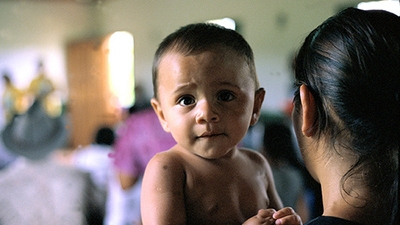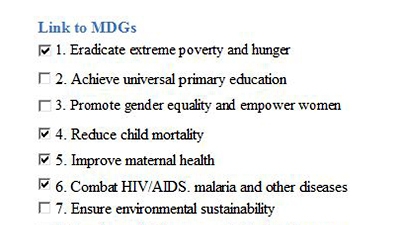CHALLENGE
Encouraging gains in halting and beginning to reverse the spread of major communicable diseases—such as HIV/AIDS and malaria—are promising, but there is still much to be done to achieve the Millennium Development Goals (MDGs). Weak health systems are undermining the ability of countries to achieve and sustain health results, and the recent financial, food, and fuel crises have made attaining the MDGs all the more challenging. Less than a fifth of IDA countries are on track to achieving MDG4 (reducing child mortality) and MDG5 (improving maternal health); progress toward maternal and child health and nutrition outcomes is particularly slow because these “neglected” MDGs are dependent on well-functioning health systems and their abilities to reach the poor. Expanding the implementation capacity of health sectors and improving the quality, efficiency, and reach of health services is critical for programs to achieve sustainable results on necessary scales. The main challenges facing middle-income countries are inequities in access to health services, poor-quality health care, large out-of-pocket expenditures for health care, and the growing burden of non-communicable diseases.
SOLUTION
The World Bank’s work in HNP focuses on strengthening country health systems to improve health results particularly for the poorest and most vulnerable. It also supports the prevention and treatment of communicable and non-communicable diseases, improves child and maternal health, nutrition, hygiene, and sanitation, and protects the poor from the impoverishing effects of high and unpredictable out-of-pocket spending. Equity and financial protection for the poor are at the core of the Bank’s HNP strategy, and the Bank supports countries in these areas through policy advice and operations. The Bank supports developing countries’ efforts to achieve universal health coverage (UHC) and provide quality, affordable health care to everyone—regardless of their ability to pay—reducing financial risks associated with ill health, and increasing equity. The Bank’s aim is to help countries build healthier, more equitable societies, as well as to improve their fiscal performance and country competitiveness—toward the goals of ending poverty and boosting shared prosperity.
An important pillar of the HNP strategy is increased use of results-based financing, which uses financial incentives to reward the delivery of one or more verified health outcomes. Results-based financing holds considerable promise for increasing health service utilization, improving service quality, increasing efficiency, and enhancing equity. It focuses attention on health results rather than inputs, thereby more tightly linking budgets and financing to results.
Given the interdependence of health outcomes and other key sectors, one of the most important aims of the HNP strategy is to foster approaches that encompass all relevant economic sectors. Building on the Bank’s comparative advantage in development finance, the Bank has supported several innovative financing mechanisms such as the IDA buy-downs (for polio), Advanced Market Commitments (to create market incentives for the rapid production, distribution, and introduction of priority vaccines at low prices), and the Affordable Medicines Facility for malaria (to accelerate the global introduction of artemisinins). Another key component of the HNP Strategy is improving monitoring and evaluation. The Bank is working with partners to develop better ways to monitor the health MDGs, and IDA is increasingly encouraging countries to carry out rigorous impact evaluations of health innovations and programs, in addition to building effective monitoring and evaluation systems.


